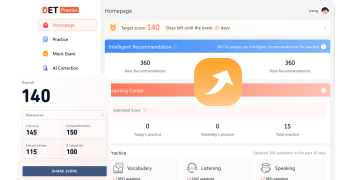Mastering the "Read, Then Speak" Section of the Duolingo English Test
The Duolingo English Test is a convenient and affordable way to assess your English proficiency online. Unlike other standardized tests, the Duolingo English Test has a unique format that adapts to your level and skills. One of the most challenging and important parts of the test is the “Read, Then Speak” section, where you have to speak about a topic for 90 seconds after reading a prompt.
In this article, we’ll show you how to ace this section and boost your Conversation and Production subscores.
We’ll cover:
- Understanding the “Read, Then Speak” Format
- Preparing to Answer
- Structuring Your Response
- Delivering Your Answer
- Enhancing Your Answer
- Incorporating a Sample Question and Demo Answer
- Practice Tips and Resources

Understanding the “Read, Then Speak” Format
The “Read, Then Speak” section is one of the four types of speaking tasks on the Duolingo English Test. It asks you to “Speak about the topic below for 90 seconds.”
For this question type, you will see a written prompt on the screen. You will have 20 seconds to read the prompt and prepare your response. Then, the test will automatically advance to the recording screen, where you will have 90 seconds to speak your response. You will still be able to see the prompt as you speak.
The prompt will usually ask you to talk about a personal experience, opinion, or preference. For example:
- Talk about your favorite restaurant.
- Discuss a time when you had to make a difficult decision.
- Describe a hobby that you enjoy.
The prompt will also include some bullet points to guide your response. For example:
- Where is it?
- What type of food does it serve?
- How often do you go there?
- Why is it your favorite?
Your response will be scored based on two subscores: Conversation and Production. Conversation measures how well you interact with the question and express your ideas. Production measures how well you use vocabulary and grammar to communicate clearly and accurately.
Preparing to Answer
The key to a successful response is to quickly understand the prompt and organize your thoughts in a short time frame. Here are some strategies to help you prepare:
- Read the prompt carefully and identify the main topic and the subtopics. For example, if the prompt is “Talk about your favorite restaurant.”, the main topic is your favorite restaurant, and the subtopics are where it is, what type of food it serves, how often you go there, and why it’s your favorite.
- Think of a specific example that relates to the main topic. For example, if your favorite restaurant is a Thai place near your home, think of a memorable time when you went there with your friends or family.
- Use the bullet points as a guide to structure your response. For example, you can start by introducing your favorite restaurant, then talk about each bullet point in order, and end with a conclusion that summarizes your main point.
- Use the 20 seconds of preparation time effectively. You can find some keywords to help you remember your main points. You can also practice saying the first sentence of your response to start confidently.
Structuring Your Response
A clear and logical response structure will help you deliver your answer smoothly and coherently. Here are some tips to help you structure your response:
- Create an introduction, a body, and a conclusion. Your introduction should briefly introduce the main topic and state your main point. Your body should develop your main point by talking about each subtopic in detail. Your conclusion should summarize your main point and end with a final remark.
- Use transition words and phrases to connect your ideas and sentences. For example, you can use words like “first”, “second”, “third”, “next”, “then”, “finally”, “also”, “however”, “for example”, “in conclusion”, etc.
- Address all parts of the prompt. Make sure you don’t skip or ignore any bullet points. If you don’t have anything to say about a subtopic, you can briefly acknowledge it and move on. For example, you can say “I don’t go there very often, but when I do, I always enjoy it.”
- Stay focused on the topic. Don’t go off on tangents or irrelevant details. If you find yourself straying from the topic, bring yourself back to the main point and the bullet points.
Delivering Your Answer
Your delivery is as important as your content. Here are some techniques to help you deliver your answer clearly and fluently:
- Speak naturally and clearly. Use a normal speaking speed and volume. Don’t speak too fast or too slow, too loud or too soft. Pronounce your words correctly and avoid mumbling or slurring.
- Use varied words and structures. Don’t repeat the same words or sentences over and over. Use synonyms, antonyms, or paraphrases to express the same idea in different ways. Use a range of vocabulary and grammatical structures to show your proficiency and accuracy.
- Manage your time well. You have 90 seconds to speak your response, which is enough to cover the prompt and the bullet points. Don’t speak too long or too short. If you finish your response before the time is up, you can add some extra details or examples to elaborate your point. If you run out of time, you can quickly wrap up your response.
- Use varied intonation and emphasis. Don’t speak in a monotone or flat voice. Use changes in pitch, volume, and stress to convey meaning and emotion. Emphasize the important words or phrases in your sentences. Use rising and falling intonation to signal questions and statements.
Enhancing Your Answer
To make your answer stand out and impress the raters, you can use some strategies to enhance your answer and demonstrate your conversational skills. Here are some ways to do that:
- Use rhetorical questions. Rhetorical questions are questions that you ask yourself or the listener, but you don’t expect an answer. They are used to engage the listener, express your thoughts, or emphasize a point. For example, you can say “Who doesn’t love Thai food, right?” or “What could be better than that?”
- Use anecdotes or stories. Anecdotes or stories are short and interesting accounts of personal experiences or events. They are used to illustrate your point, provide examples, or add humor. For example, you can say “One time, I ordered the spiciest dish on the menu, and I regretted it so much. My mouth was on fire, and I had to drink three glasses of water to cool it down.”
- Use opinions or feelings. Opinions or feelings are your personal views or emotions about a topic. They are used to show your personality, perspective, or attitude. For example, you can say “I think Thai food is the best cuisine in the world.” or “I feel so happy and relaxed when I go to my favorite restaurant.”
A Sample Question and Demo Answer
To give you a better idea of how to apply the tips and strategies we’ve discussed, let’s look at a sample question and a demo answer for the “Read, Then Speak” section.
Sample Question:
Discuss a time when you had to make a difficult decision.
What was the situation?
What choices were available to you?
Why did you make the decision you did?
Demo Answer:
Well, I’d say one of the toughest decisions I’ve ever had to make was figuring out where I wanted to go to college after I finished up high school. I had gotten accepted to a few different schools and it definitely wasn’t an easy choice to make.
Let’s see, first off, I should probably give you some background real quick on the different colleges I got into. There was this small liberal arts college pretty close to home that I applied to. It was a nice little school. Then there was this huge state university that was like 5 hours away – it was really big with tons of students. And last, I applied to this Ivy League school all the way on the other side of the country. I had worked really hard to get awesome grades and test scores in high school so I could have some good options to choose from.
So each school had their own pros and cons that I had to think about. The small college was nearby and I already knew some kids going there. But it didn’t have the big name like the Ivy League did. The state school was a lot more affordable but it was so big I worried I wouldn’t get enough personal attention from professors. And the Ivy League school was super prestigious, but way more competitive and expensive too.
After visiting all 3 campuses, I decided the small liberal arts college was the best option for me. I really liked the small class sizes and how tight-knit the community felt. They also gave me a great financial aid package that made it possible to afford. I knew I’d get to work closely with professors and get individualized attention there, and that was huge for me.
So in the end, I went with my gut telling me the small school was the right call. I didn’t want to pass up the chance to really get mentored and be part of a community just because the Ivy League name carried more weight. And I’m stoked with my choice – I’ve gotten to have experiences at this school I don’t think I would’ve had anywhere else. So for me, I’m happy with my decision.
Practice Tips and Resources
The best way to improve your speaking skills and prepare for the “Read, Then Speak” section is to practice regularly and consistently. Here are some methods and resources to help you practice:
- Simulate the test environment. Try to recreate the conditions of the actual test as much as possible. Use a computer with a webcam and a microphone and find a quiet and comfortable place to take the test. Set a timer for 20 seconds to read the prompt and 90 seconds to speak your response. Record yourself and listen to your performance. Identify your strengths and weaknesses, and work on improving them.
- Use online resources. Many online resources can help you practice your speaking skills and prepare for the Duolingo English Test. For example, you can use the official DET website to learn more about the test format, scoring, and tips. You can also use our Duolingo English Test practice question bank to familiarize yourself with the test.
Click here for more DET Preparation Strategies
Look for tips on DET? Find out here: https://www.detpractice.com/category/pro-test-tips/
Start practicing today by signing up for our DET question bank for free.






